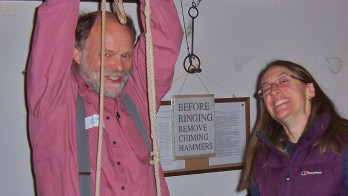M1: 19 Oct 2013 - Over
Eighteen members of the Ely Diocesan Association gathered at St Mary’s Church and Church Hall at Over in Cambridgeshire on Saturday 19 October to attend Module 1 of the Integrated Teacher Training Scheme (ITTS), ‘Teaching Bell Handling’. Organised by the Association’s Education Officer, Philip Bailey, this was the first ITTS Day Course to be run in the Diocese of Ely.
Led by ITTS Tutor Graham Nabb of the Association of Ringing Teachers, the attendees comprised both new ringing teachers and experienced mentors in equal numbers. Each trainee teacher chooses or is assigned a mentor (normally an established and well-regarded ringing teacher in the area) who will work with the teacher throughout their subsequent training of a new ringer in the art of bell handling in order to demonstrate their ability and achieve Module 1 accreditation.
The day’s programme was divided into three theory and three practical sessions, in the first of which teachers and mentors learned how to teach a skilled activity and then put this into practice in the ringing chamber by going through the basic components of bell handling together. The second half of the morning concentrated on becoming a good teacher, including recognising the different types of learner (visual, auditory or kinaesthetic) and learning what teaching style and techniques work most effectively in each case. The following practical session used joining both strokes together to practice the application of the most appropriate teaching techniques.
After a hearty lunch of sandwiches and cakes provided by Dee Smith of Burwell, the afternoon started with a practical session on teaching how to ring up and down, returning to the Church Hall for a theory session on solving handling problems. This was followed by the last practical session of the day when solving common handling problems was put to the test in the St Mary’s ringing chamber.
Returning to the Church Hall for the closing session, Delegates heard from Graham Nabb what was then expected of them in order to progress to completion of Module 1. Each teacher participant would receive a user name and password to be able to log in to Moodle, the ART learning website where they will subsequently be able to record their progress towards completion of Module 1 and beyond. The first task, however, was to take and pass an on-line theory test before embarking on the identification of a suitable new learner for subsequent training to handle a bell correctly, ring handstrokes and backstrokes together, and ring a bell up and down. The teacher’s mentor judges when this training has been delivered effectively and then arranges for an independent assessment by another mentor to confirm before submitting recommendation for accreditation.
The organised and progressive approach to teaching bell handling promoted by the ITTS was positively received by the course attendees. Barbara Le Gallez of Landbeach said, “I thought that the content of the course was good and Graham Nabb presented it professionally. I also thought Graham proved a very skilled teacher of bell handling and I benefited from his comments on my handling”.
Richard Pargeter of Balsham added, “I went along because I wanted to be part of ITTS / ART, and not in the hopes or expectation of learning very much new (I’ve been at this for nearly 30 years now!), but I did nevertheless come across some new ideas which I shall be trying out”. Paul Newman of Litlington summed up the experience of many: “Since completing the ITTS Module 1 I have new and different methods for teaching a new ringer. More tools in my toolbox!”.
Peter Binns

Course Tutor: Graham Nabb
Teaching Bell Handling
Practical advice for teachers, right from the first lesson.